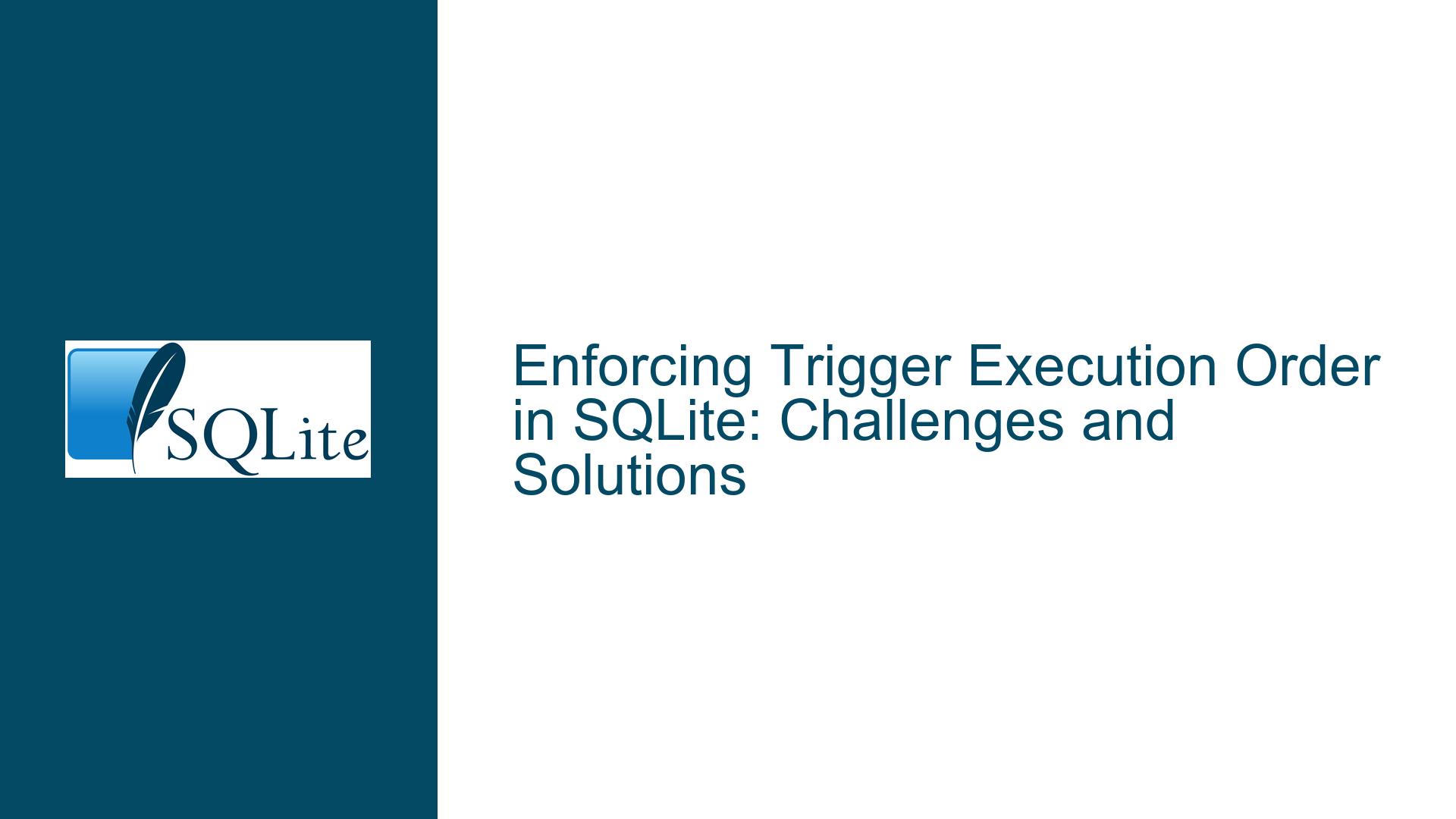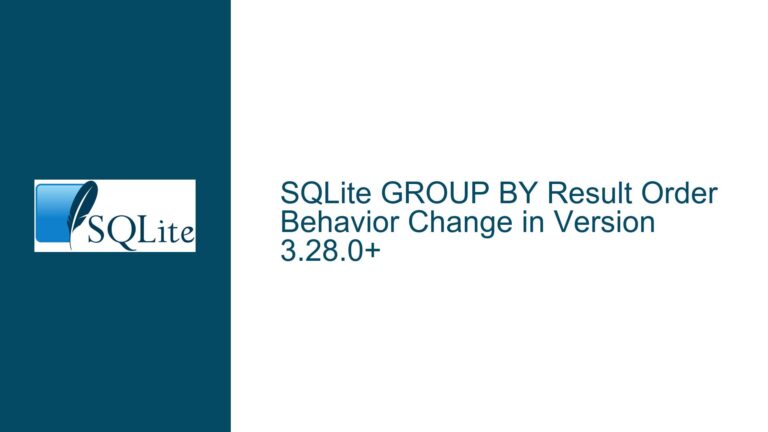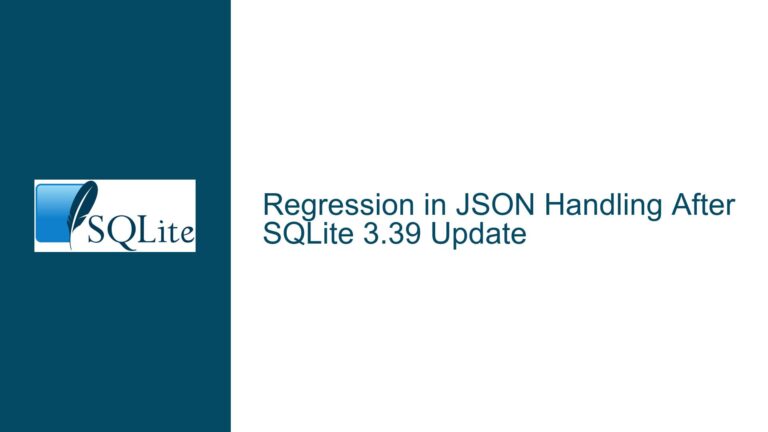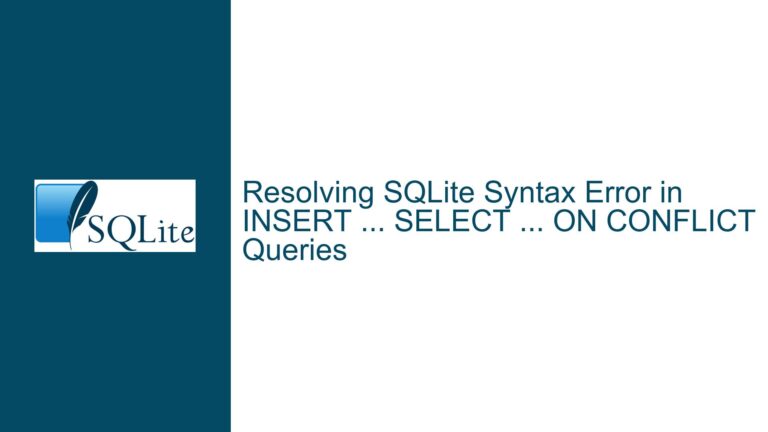Enforcing Trigger Execution Order in SQLite: Challenges and Solutions
SQLite Trigger Execution Order Ambiguity
SQLite, a widely-used lightweight relational database management system, provides robust support for database triggers, which are essential for automating data integrity checks, enforcing business rules, and maintaining audit trails. However, one of the persistent challenges faced by developers is the ambiguity surrounding the execution order of triggers in SQLite. Unlike some other database systems, SQLite does not explicitly guarantee the order in which triggers of the same category (BEFORE, AFTER, or INSTEAD OF) will fire. This can lead to unpredictable behavior in complex database schemas where multiple triggers are defined on the same table for the same event.
The core of the issue lies in the fact that SQLite does not follow a strict standard for trigger execution order based on their creation sequence. While some database systems, such as PostgreSQL, allow developers to enforce trigger order by naming conventions or explicit ordering mechanisms, SQLite lacks such built-in functionality. This can be particularly problematic in scenarios where the outcome of one trigger depends on the successful execution of another. For instance, if two BEFORE INSERT triggers are defined on a table, and the second trigger relies on modifications made by the first, the absence of a guaranteed execution order can lead to inconsistent results.
To further complicate matters, SQLite’s internal mechanism for trigger execution is not well-documented, making it difficult for developers to predict or control the sequence in which triggers are fired. This lack of transparency can result in subtle bugs that are hard to diagnose and resolve. For example, a developer might assume that triggers are executed in the order they were created, only to find that this assumption does not hold true in all cases. This unpredictability can be especially problematic in environments where data integrity is critical, such as financial systems or healthcare applications.
In summary, the ambiguity surrounding SQLite’s trigger execution order poses a significant challenge for developers who need to ensure consistent and predictable behavior in their database applications. Without a clear mechanism to enforce trigger order, developers must resort to alternative strategies, such as consolidating multiple triggers into a single trigger or using procedural logic within triggers to manage dependencies. These workarounds, while effective, can introduce additional complexity and reduce the maintainability of the database schema.
Unpredictable Trigger Order Due to Lack of Explicit Control
The unpredictability of trigger execution order in SQLite stems from the database’s design philosophy, which prioritizes simplicity and lightweight operation over complex features. Unlike more heavyweight databases like PostgreSQL or Oracle, SQLite does not provide built-in mechanisms to explicitly control the order in which triggers are executed. This design choice can lead to several potential issues, particularly in scenarios where multiple triggers are defined on the same table for the same event.
One of the primary causes of this unpredictability is the absence of a standardized ordering mechanism. In SQLite, triggers are stored in the sqlite_master table, which is an internal system table that contains metadata about the database schema. When a trigger is created, it is added to this table, but the order in which triggers are stored does not necessarily correspond to the order in which they will be executed. This means that even if triggers are created in a specific sequence, there is no guarantee that they will fire in that same sequence when the associated event occurs.
Another contributing factor is the way SQLite handles trigger execution internally. When a trigger event occurs, SQLite’s query planner determines the order in which to execute the triggers based on internal algorithms that are not exposed to the user. These algorithms may take into account various factors, such as the type of trigger (BEFORE, AFTER, or INSTEAD OF) and the specific event (INSERT, UPDATE, or DELETE), but the exact logic is not documented. As a result, developers have no way to influence or predict the execution order, leading to potential inconsistencies in behavior.
Furthermore, the lack of explicit control over trigger order can exacerbate issues related to trigger dependencies. In complex database schemas, it is common for one trigger to depend on the actions of another. For example, a BEFORE INSERT trigger might modify a column value, and a subsequent BEFORE INSERT trigger might rely on that modified value to perform additional checks or modifications. If the execution order is not guaranteed, the second trigger might execute before the first, leading to incorrect results or even data corruption.
In addition to these technical challenges, the unpredictability of trigger execution order can also impact the maintainability and readability of the database schema. Developers may be forced to write more complex triggers to account for the lack of order guarantees, which can make the schema harder to understand and maintain. This is particularly problematic in large projects with multiple developers, where clear and predictable behavior is essential for ensuring the integrity and reliability of the database.
In conclusion, the lack of explicit control over trigger execution order in SQLite is a significant limitation that can lead to unpredictable behavior, particularly in complex database schemas. While SQLite’s design philosophy prioritizes simplicity and lightweight operation, this can come at the cost of reduced flexibility and control for developers. As a result, developers must be aware of these limitations and adopt strategies to mitigate the risks associated with unpredictable trigger execution order.
Consolidating Triggers and Using Procedural Logic for Predictable Execution
Given the challenges associated with unpredictable trigger execution order in SQLite, developers must adopt strategies to ensure consistent and predictable behavior. One effective approach is to consolidate multiple triggers into a single trigger, thereby eliminating the need to rely on execution order. This can be achieved by combining the logic of multiple triggers into a single trigger body, using conditional statements to handle different scenarios.
For example, consider a scenario where two BEFORE INSERT triggers are defined on a table, each performing a different set of operations. Instead of defining two separate triggers, developers can combine the logic into a single trigger, using conditional statements to ensure that the operations are performed in the correct sequence. This approach not only eliminates the ambiguity of trigger execution order but also simplifies the database schema, making it easier to maintain and understand.
Another strategy is to use procedural logic within triggers to manage dependencies. In SQLite, triggers can include procedural logic written in SQL or using extensions like SQLite’s C API. By embedding procedural logic within a trigger, developers can explicitly control the sequence of operations, ensuring that each step is executed in the correct order. For example, a trigger might first perform a data validation check, then modify a column value, and finally log the changes to an audit table. By encapsulating these steps within a single trigger, developers can ensure that they are executed in the desired sequence, regardless of the order in which other triggers might fire.
In addition to these strategies, developers can also leverage SQLite’s PRAGMA statements to influence trigger behavior. For example, the PRAGMA defer_foreign_keys statement can be used to defer the enforcement of foreign key constraints until the end of a transaction. This can be particularly useful in scenarios where triggers modify data in ways that might temporarily violate foreign key constraints. By deferring the enforcement of these constraints, developers can ensure that the triggers execute without interruption, reducing the risk of data corruption or inconsistent behavior.
Furthermore, developers can use SQLite’s WITH clause to create common table expressions (CTEs) within triggers. CTEs allow developers to define temporary result sets that can be referenced within the trigger body, making it easier to manage complex logic and dependencies. For example, a trigger might use a CTE to calculate a derived value, which is then used in subsequent operations within the trigger. By using CTEs, developers can break down complex logic into manageable steps, ensuring that each step is executed in the correct sequence.
Finally, developers should consider the use of transaction control statements within triggers to ensure atomicity and consistency. SQLite supports transaction control statements like BEGIN, COMMIT, and ROLLBACK, which can be used within triggers to manage the scope of operations. By wrapping trigger logic within a transaction, developers can ensure that all operations are executed as a single unit, reducing the risk of partial updates or inconsistent data. This is particularly important in scenarios where multiple triggers are involved, as it ensures that the database remains in a consistent state even if one of the triggers fails.
In conclusion, while SQLite’s lack of explicit control over trigger execution order poses challenges, developers can adopt several strategies to ensure consistent and predictable behavior. By consolidating triggers, using procedural logic, leveraging PRAGMA statements, and employing transaction control, developers can mitigate the risks associated with unpredictable trigger execution order and maintain the integrity and reliability of their database applications.






